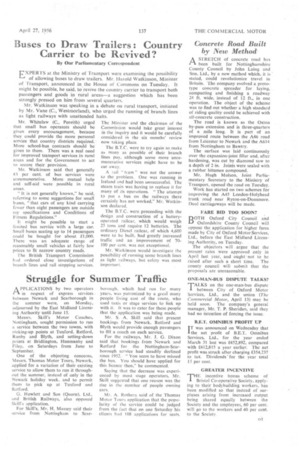Buses to Draw Trailers: Country Carrier to be Revived?
Page 51

If you've noticed an error in this article please click here to report it so we can fix it.
By Our Parliamentary Correspondent
EXPERTS at the Ministry of Transport were examining the possibility of allowing buses to draw trailers. Mr. Harold Watkinson, Minister of Transport, announced in the House of Commons on Tuesday. It might be possible, he said, to revive the country carrier to transport both passengers and goods in rural areas—a suggestion which has been strongly pressed on him from several quarters.
Mr. Watkinson was speaking in a debate on rural transport, initiated by Mr. Vane (C., Westmorland), Who urged the running of branch lines as light railways with unattended halts.
Mr. Whitelaw (C., Penrith) urged that small bus operators should be given every encouragement, because they could provide the more personal service that country districts required. More school-bus contracts should be given to them. There was a real need for improved transport services in rural areas and for the Government to act to secure their provision.
Mr. Watkinson said that generally 43 per cent, of bus services were unremunerative. More• mutual help and self-aid were possible in rural areas.
"It is not generally known," he said, referring to some suggestions for small buses, "that cars of any kind carrying fewer than eight passengers are outside my specifications and Conditions of Fitness Regulations."
Ti might be possible to start a limited bus service with a large car. Small buses seating up to 14 passengers could be bought for about £1,000. There was an adequate range of reasonably small vehicles at fairly low prices to fit narrow country roads.
The British Transport Commission h,td ordered close investigations of branch lines and rail stopping Services. The Minister and the chairman of the Commission would take great interest in the inquiry and it would be carefully considered in the six months' review now taking place.
The B.T.C. were to try again to make as many as possible of their branch lines pay, although some more unremunerative services might have to be cut away.
A rail " tiam " was not the answer to the problem. One was running in Ireland and had been unsuccessful, The steam train was having to replace it for many of its operations. "The attempt to put a bus on the railways there certainly has not worked," Mr. Watkinson declared.
The B.T.C. were proceeding with the design and construction of a battery. operated railcar, which would weigh 25 tons and require 12 batteries. The ordinary Diesel railcar, of which 4,600 were to be built, had greatly increased traffic and an improvement of 70IOU per cent, was not exceptional.
Mr. Watkinson would investigate the possibility of running some branch lines as light railways, but safety was most importani.




































































































































